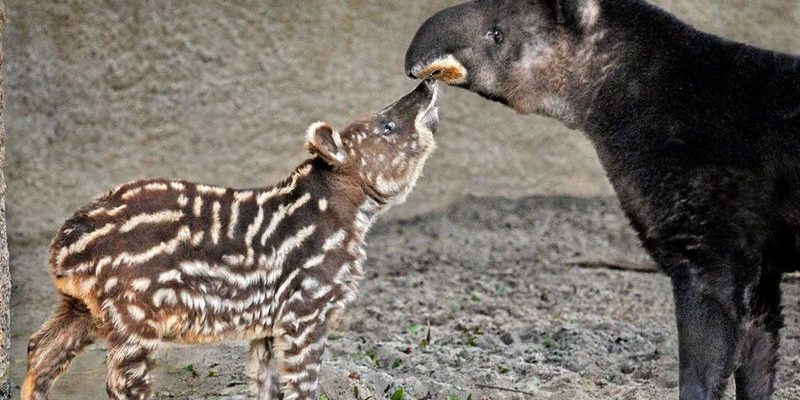
Mountain tapirs are built like a tank but are surprisingly delicate at the same time. They are the smallest of the three tapir species and have thick, woolly fur that keeps them warm against the cold. Think of them as nature’s cozy winter jackets, but much more active! As we dive deeper into this topic, we’ll explore how these gentle giants handle their rugged surroundings.
Physical Adaptations for Cold Environments
Mountain tapirs have some truly remarkable physical features that help them survive in their chilly habitats. Their thick, dense fur is one of the most impressive adaptations. It acts like insulation, keeping them warm despite the cold mountain air. Picture wrapping yourself in a heavy, warm blanket; that’s how cozy these animals feel even when temperatures plummet.
Another interesting adaptation is their short legs and robust bodies. These features allow them to navigate the steep, rocky terrain of the Andes with ease. When you think about it, if you were trying to maneuver through a tough landscape, having a sturdy build would be a huge advantage, wouldn’t it? These adaptations help the tapirs move skillfully through their environment while conserving energy, which is crucial when food is not always readily available.
Lastly, their large, rounded feet are designed to provide excellent traction on slippery surfaces. If you’ve ever tried walking on ice, you know how important good footing is. The mountain tapir’s feet help it avoid slips and falls, which can be dangerous in their steep habitat. These physical traits combine to give mountain tapirs a better chance of thriving in harsh conditions.
Diet and Foraging Strategies
Mountain tapirs are herbivores, feeding primarily on a variety of vegetation, including leaves, fruits, and shrubs. You might be wondering, *how do they find enough food in such a challenging environment?* Well, mountain tapirs are masters at foraging. They seek out specific plants that thrive in their altitude, making them quite selective eaters.
Their long, flexible snouts allow them to reach high branches and dense underbrush. Imagine using chopsticks to pick your favorite snacks from a pile of treats—that’s kind of what they do with their noses! With this unique ability, they can access food that many other animals can’t, reducing competition for limited resources.
Additionally, mountain tapirs are known to have a varied diet, which helps them adapt to different seasons. When fruits are scarce in winter, they’ll shift their diet to include more tough leaves and bark. This flexibility is critical for survival, as it ensures they always have something to munch on.
Behavioral Adaptations for Survival
Beyond their physical traits, mountain tapirs exhibit specific behaviors that enhance their survival. One key behavior is their ability to be crepuscular. This means they’re most active during twilight hours—early morning and late afternoon. By avoiding the extreme temperatures of midday, they minimize energy expenditure and reduce the risk of overheating.
Have you ever noticed how some animals seem to hug the shadows on a hot day? That’s exactly what mountain tapirs do! They also tend to stay in dense cover, which helps them remain hidden from potential predators. This camouflage is essential in their survival toolkit, allowing them to live in harmony with the dangers around them.
Another fascinating aspect of their behavior is their social structure. Mountain tapirs are generally solitary, which may sound lonely, but it helps reduce competition for food. When you’re living in a harsh environment, sometimes, less is more! And even though they prefer solitude, they will occasionally come together to mate or raise their young, ensuring the continuation of their species while still managing their energy and resources wisely.
Adaptation to High Altitude
Living in high-altitude environments presents unique challenges, particularly regarding oxygen levels. As altitude increases, the availability of oxygen decreases. This is where mountain tapirs show their extraordinary ability to adapt. They have larger lungs and a more efficient circulatory system, allowing them to take in the limited oxygen available.
You might think about climbing a mountain yourself and how you’d feel out of breath! Mountain tapirs, however, are built for this. Their bodies have adapted to make the most of every breath, ensuring they maintain adequate oxygen levels even in thinner air. This adaptation is vital, as it supports their physical activity and helps them forage for food.
Moreover, these creatures have an efficient metabolism that allows them to extract more nutrients from the food they consume. It’s like having a high-performance engine that runs efficiently even on low-grade fuel. This efficiency helps them thrive where many other animals would struggle to survive.
Conservation Challenges and Efforts
Despite their robust adaptations, mountain tapirs face several threats that endanger their survival. Habitat loss due to deforestation and agricultural expansion is one of the most pressing issues. As humans encroach on their territory, these gentle animals are pushed into smaller and smaller areas.
You might be thinking, *What can be done about it?* Well, conservation efforts are underway. Various organizations are working to protect the habitats of mountain tapirs by establishing reserves and promoting sustainable land-use practices. These initiatives aim to create safe spaces where mountain tapirs can thrive without the looming threat of human development.
Education also plays a crucial role in conservation. By raising awareness about mountain tapirs and their ecological importance, people can help foster a greater appreciation for these unique creatures. After all, the more we know about them, the more likely we are to protect them, right?
Mountain tapirs are a remarkable example of resilience in the face of adversity. Their physical and behavioral adaptations allow them to thrive in one of the harshest environments on Earth. From their thick coats that insulate against the frigid air to their adept foraging techniques, these creatures have carved out a niche for themselves in the Andes.
As we continue to face global challenges like climate change and habitat loss, the story of the mountain tapir reminds us of the importance of protecting our planet’s unique wildlife. By understanding their needs and supporting conservation efforts, we can help ensure that these extraordinary animals continue to roam the mountains for generations to come. So next time you hear about mountain tapirs, you’ll know just how special they are and what makes them such resilient survivors in a tough world.

